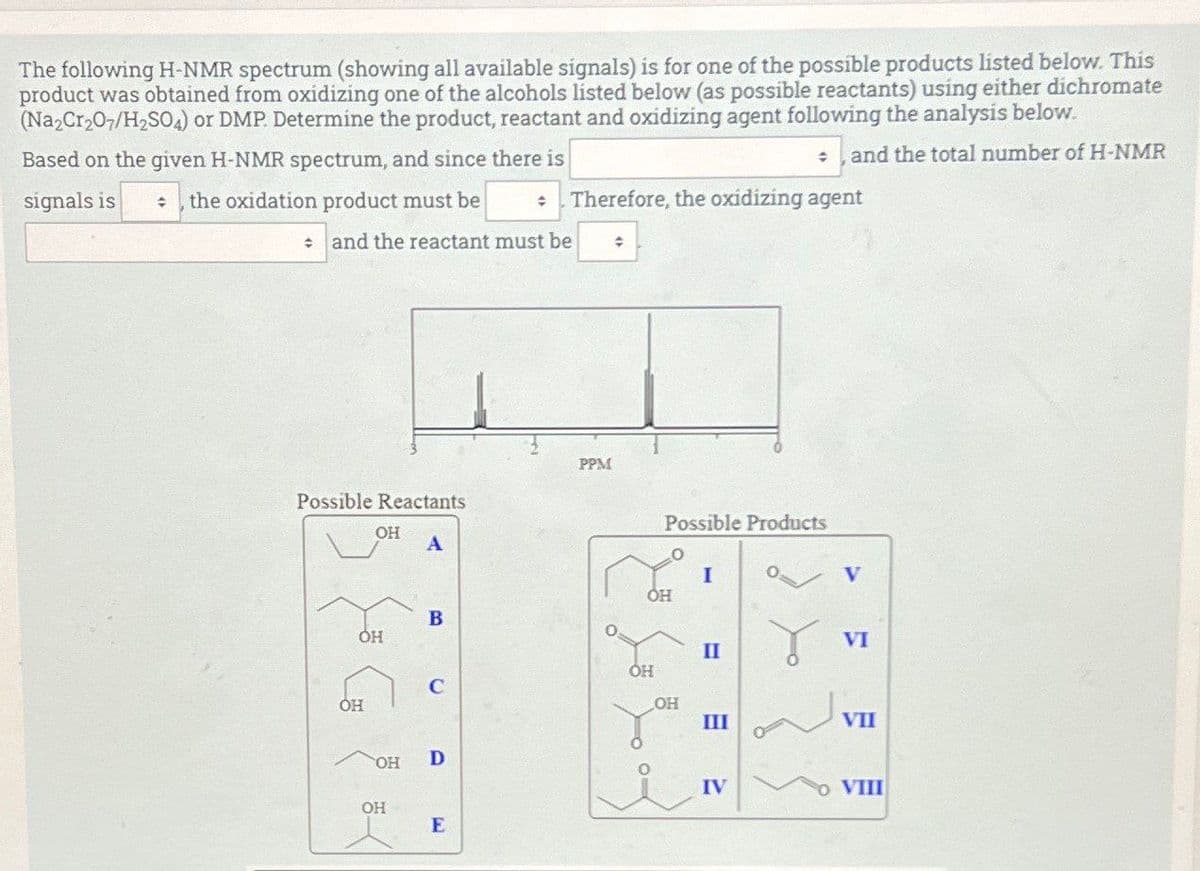The following H-NMR spectrum (showing all available signals) is for one of the possible products listed below. This product was obtained from oxidizing one of the alcohols listed below (as possible reactants) using either dichromate (Na2Cr2O7/H2SO4) or DMP. Determine the product, reactant and oxidizing agent following the analysis below. Based on the given H-NMR spectrum, and since there is signals is and the total number of H-NMR the oxidation product must be Therefore, the oxidizing agent and the reactant must be PPM Possible Reactants Possible Products OH A I V OH B OH VI II تم ها OH C OH III VII D OH E IV VIII
The following H-NMR spectrum (showing all available signals) is for one of the possible products listed below. This product was obtained from oxidizing one of the alcohols listed below (as possible reactants) using either dichromate (Na2Cr2O7/H2SO4) or DMP. Determine the product, reactant and oxidizing agent following the analysis below. Based on the given H-NMR spectrum, and since there is signals is and the total number of H-NMR the oxidation product must be Therefore, the oxidizing agent and the reactant must be PPM Possible Reactants Possible Products OH A I V OH B OH VI II تم ها OH C OH III VII D OH E IV VIII
Chemistry
10th Edition
ISBN:9781305957404
Author:Steven S. Zumdahl, Susan A. Zumdahl, Donald J. DeCoste
Publisher:Steven S. Zumdahl, Susan A. Zumdahl, Donald J. DeCoste
Chapter1: Chemical Foundations
Section: Chapter Questions
Problem 1RQ: Define and explain the differences between the following terms. a. law and theory b. theory and...
Related questions
Question

Transcribed Image Text:The following H-NMR spectrum (showing all available signals) is for one of the possible products listed below. This
product was obtained from oxidizing one of the alcohols listed below (as possible reactants) using either dichromate
(Na2Cr2O7/H2SO4) or DMP. Determine the product, reactant and oxidizing agent following the analysis below.
Based on the given H-NMR spectrum, and since there is
signals is
and the total number of H-NMR
the oxidation product must be
÷
Therefore, the oxidizing agent
and the reactant must be
PPM
Possible Reactants
OH
A
Possible Products
O
I
V
ОН
B
ОН
VI
II
ОН
C
ОН
OH
III
VII
OH
D
OH
E
IV
VIII
Expert Solution
This question has been solved!
Explore an expertly crafted, step-by-step solution for a thorough understanding of key concepts.
Step by step
Solved in 3 steps with 2 images

Knowledge Booster
Learn more about
Need a deep-dive on the concept behind this application? Look no further. Learn more about this topic, chemistry and related others by exploring similar questions and additional content below.Recommended textbooks for you

Chemistry
Chemistry
ISBN:
9781305957404
Author:
Steven S. Zumdahl, Susan A. Zumdahl, Donald J. DeCoste
Publisher:
Cengage Learning

Chemistry
Chemistry
ISBN:
9781259911156
Author:
Raymond Chang Dr., Jason Overby Professor
Publisher:
McGraw-Hill Education

Principles of Instrumental Analysis
Chemistry
ISBN:
9781305577213
Author:
Douglas A. Skoog, F. James Holler, Stanley R. Crouch
Publisher:
Cengage Learning

Chemistry
Chemistry
ISBN:
9781305957404
Author:
Steven S. Zumdahl, Susan A. Zumdahl, Donald J. DeCoste
Publisher:
Cengage Learning

Chemistry
Chemistry
ISBN:
9781259911156
Author:
Raymond Chang Dr., Jason Overby Professor
Publisher:
McGraw-Hill Education

Principles of Instrumental Analysis
Chemistry
ISBN:
9781305577213
Author:
Douglas A. Skoog, F. James Holler, Stanley R. Crouch
Publisher:
Cengage Learning

Organic Chemistry
Chemistry
ISBN:
9780078021558
Author:
Janice Gorzynski Smith Dr.
Publisher:
McGraw-Hill Education

Chemistry: Principles and Reactions
Chemistry
ISBN:
9781305079373
Author:
William L. Masterton, Cecile N. Hurley
Publisher:
Cengage Learning

Elementary Principles of Chemical Processes, Bind…
Chemistry
ISBN:
9781118431221
Author:
Richard M. Felder, Ronald W. Rousseau, Lisa G. Bullard
Publisher:
WILEY